In computing and telecommunication, a control character or non-printing character (NPC) is a code point in a character set that does not represent a written character or symbol. They are used as in-band signaling to cause effects other than the addition of a symbol to the text. All other characters are mainly graphic characters, also known as printing characters, except perhaps for "space" characters. In the ASCII standard there are 33 control characters, such as code 7, BEL, which rings a terminal bell.

Unicode, formally The Unicode Standard, is a text encoding standard maintained by the Unicode Consortium designed to support the use of text in all of the world's writing systems that can be digitized. Version 15.1 of the standard defines 149813 characters and 161 scripts used in various ordinary, literary, academic, and technical contexts.
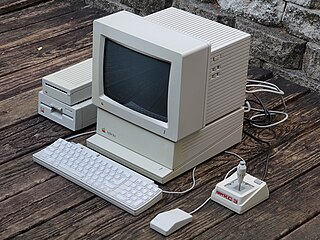
The Apple IIGS is a 16-bit personal computer produced by Apple Computer. It is the fifth and most powerful of the Apple II family. It is compatible with earlier Apple II models but has a Macintosh look and feel, and resolution and color similar to the Amiga and Atari ST. The "GS" in the name stands for "Graphics and Sound", referring to its enhanced multimedia hardware, especially its state-of-the-art audio.
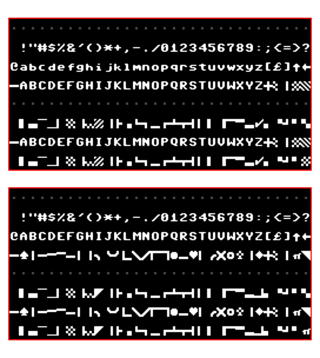
PETSCII, also known as CBM ASCII, is the character set used in Commodore Business Machines' 8-bit home computers.
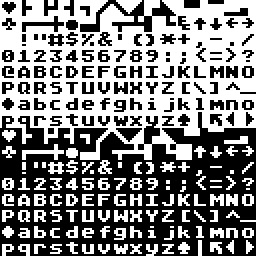
The ATASCII character set, from ATARI Standard Code for Information Interchange, alternatively ATARI ASCII, is a character encoding used in the Atari 8-bit home computers. ATASCII is based on ASCII, but is not fully compatible with it.

Windows Console is the infrastructure for console applications in Microsoft Windows. An instance of a Windows Console has a screen buffer and an input buffer. It allows console apps to run inside a window or in hardware text mode. The user can switch between the two using the Alt+↵ Enter key combination. The text mode is unavailable in Windows Vista and later. Starting with Windows 10, however, a native full-screen mode is available.

ArmSCII or ARMSCII is a set of obsolete single-byte character encodings for the Armenian alphabet defined by Armenian national standard 166–9. ArmSCII is an acronym for Armenian Standard Code for Information Interchange, similar to ASCII for the American standard. It has been superseded by the Unicode standard.

Code page 437 is the character set of the original IBM PC. It is also known as CP437, OEM-US, OEM 437, PC-8, or DOS Latin US. The set includes all printable ASCII characters as well as some accented letters (diacritics), Greek letters, icons, and line-drawing symbols. It is sometimes referred to as the "OEM font" or "high ASCII", or as "extended ASCII".
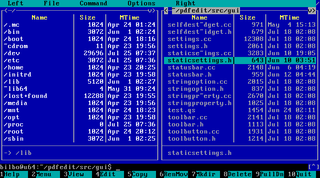
Box-drawing characters, also known as line-drawing characters, are a form of semigraphics widely used in text user interfaces to draw various geometric frames and boxes. These characters are characterized by being designed to be connected horizontally and/or vertically with adjacent characters, which requires proper alignment. Box-drawing characters therefore typically only work well with monospaced fonts.
Several 8-bit character sets (encodings) were designed for binary representation of common Western European languages, which use the Latin alphabet, a few additional letters and ones with precomposed diacritics, some punctuation, and various symbols. These character sets also happen to support many other languages such as Malay, Swahili, and Classical Latin.
MouseText is a set of 32 graphical characters designed by Bruce Tognazzini and first implemented in the Apple IIc. They were then retrofitted to the Apple IIe forming part of the Enhanced IIe upgrade. A slightly revised version was then released with the Apple IIGS.

In CJK computing, graphic characters are traditionally classed into fullwidth and halfwidth characters. Unlike monospaced fonts, a halfwidth character occupies half the width of a fullwidth character, hence the name.

The ZX Spectrum character set is the variant of ASCII used in the ZX Spectrum family computers. It is based on ASCII-1967 but the characters ^, ` and DEL are replaced with ↑, £ and ©. It also differs in its use of the C0 control codes other than the common BS and CR, and it makes use of the 128 high-bit characters beyond the ASCII range. The ZX Spectrum's main set of printable characters and system font are also used by the Jupiter Ace computer.
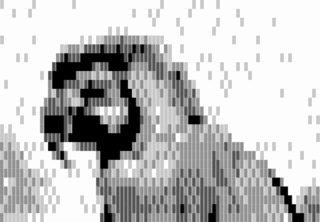
Text-based semigraphics, pseudographics, or character graphics is a primitive method used in early text mode video hardware to emulate raster graphics without having to implement the logic for such a display mode.

The ZX80 character set is the character encoding used by the Sinclair Research ZX80 microcomputer with its original 4K BASIC ROM. The encoding uses one byte per character for 256 code points. It has no relationship with previously established ones like ASCII or EBCDIC, but it is related though not identical to the character set of the successor ZX81.

The ZX81 character set is the character encoding used by the Sinclair Research ZX81 family of microcomputers including the Timex Sinclair 1000 and Timex Sinclair 1500. The encoding uses one byte per character for 256 code points. It has no relationship with previously established ones like ASCII or EBCDIC, but it is related though not identical to the character set of the predecessor ZX80.

The Atari ST character set is the character set of the Atari ST personal computer family including the Atari STE, TT and Falcon. It is based on code page 437, the original character set of the IBM PC.
Symbols for Legacy Computing is a Unicode block containing graphic characters that were used for various home computers from the 1970s and 1980s and in Teletext broadcasting standards. It includes characters from the Amstrad CPC, MSX, Mattel Aquarius, RISC OS, MouseText, Atari ST, TRS-80 Color Computer, Oric, Texas Instruments TI-99/4A, TRS-80, Minitel, Teletext, ATASCII, PETSCII, ZX80, and ZX81 character sets. Semigraphics characters are also included in the form of new block-shaped characters, line-drawing characters, and 60 "sextant" characters.
The Amstrad CPC character set is the character set used in the Amstrad CPC series of 8-bit personal computers when running BASIC. This character set existed in the built-in "lower" ROM chip. It is based on ASCII-1967, with the exception of character 0x5E which is the up arrow instead of the circumflex, as it is in ASCII-1963, a feature shared with other character sets of the time. Apart from the standard printable ASCII range (0x20-0x7e), it is completely different from the Amstrad CP/M Plus character set. The BASIC character set had symbols of particular use in games and home computing, while the CP/M Plus character reflected the International and Business flavor of the CP/M Plus environment. This character set is represented in Unicode as of the March 2020 release of Unicode 13.0, which added symbols for legacy computing. The three missing characters have however been accepted for inclusion in Unicode 16.0 in the symbols for legacy computing supplement.














